By Dave DeWitt
Recipes:Classic North Indian |
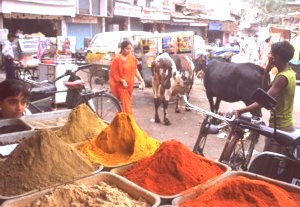
Ground Curry Spices in the Main Market, Delhi. Photo by Victor Paul Borg.
The Debate Over Commercial Curry Preparations
Many purists abhor commercial curry powders. “They are anathema to Indian cooking,” wrote Dharamjit Singh, author of Indian Cookery, “prepared for imaginary palates, having neither the delicacy nor the perfume of flowers and sweet-smelling herbs, nor the savour and taste of genuine aromatics.” He added: “Curry powders often contain inferior spices which with age become acrid and medicinal in taste. They not only mask the natural taste of foods, but lend a weary sameness to everything with which they are used.”
Pat Chapman, the U.K.’s “King of Curries,” notes another drawback to commercial powders. “The manufacturers,” he writes, “often put in too much chile and salt, and in some cases, chemical colorings and preservatives. Undeclared additives can include husks and stalks, and other adulterations.” (In India, salt is added to curry powder to inhibit the formation of mold.) Noted author and curry lover Elizabeth David also turned her nose up at prepared curry powders. “To me they are unlikeable,” she wrote, “harshly flavored, and possessed of an aroma clinging and all-pervading in its way as English boiled cabbage or cauliflower. Too much hot red pepper, too much low-grade ginger, too much mustard seed and fenugreek….”
Juel Anderson, author of The Curry Primer, has pointed out: “Through time, commercial spice mixtures have become so uniform a blend that most of us know curries only as yellow-colored foods with a standard aroma, often peppery-hot and as predictable in flavor as a Big Mac.” Indeed, there is a sameness to commercial curry powders, especially those made in the United States to the 1977 USDA standards for curry powder, which calls for the following percentages of spices: coriander, 36; turmeric, 28; cumin, 10; fenugreek, 10; white pepper, 5; allspice, 4; mustard, 3; red pepper, 2; and ginger, 2. However, I should point out that there are many imported curry powders, especially from India, which vary in flavor considerably because they contain a wider variety of spices used in many different percentages. Here is a selection of prepared curry powders:
 |
 |
Commercial curry powders are basically convenience condiments and should be treated that way. Cookbook author John Philips Cranwell suggests three reasons for using commercial curry preparations: they produce a uniform result with a given recipe; the individual spices necessary to make a certain curry may not be available at a given time; and buying commercial curry preparations saves kitchen time and work. I believe that common sense must prevail. It may be true, Singh suggests, that: “Once you have tried [separate spices] you will no more use the packaged curry powder than you would accept another person’s taste in the choice of your clothes.” But, on the other hand, is it considered bad taste to use a packaged Sri Lankan curry paste if the cook has run out of some of the necessary ingredients to prepare a fresh curry paste? Or, if fresh lemongrass is not immediately available for a Thai curry, should the cook substitute powdered lemon grass, or use a bottled curry paste containing fresh lemongrass? These are decisions only the cook can make, and there will certainly be times when convenience will triumph over authenticity. Here is an example of a selection bottled green curry paste.
 My recommendation is that, whenever possible, cooks should follow the recipes in this series and use freshly ground or mixed ingredients for the curries. Prepared powders and other products can be a backup for cooks lacking the time or certain essential ingredients, but cooks should, whenever possible, avoid the cheap American-made curry powders.
My recommendation is that, whenever possible, cooks should follow the recipes in this series and use freshly ground or mixed ingredients for the curries. Prepared powders and other products can be a backup for cooks lacking the time or certain essential ingredients, but cooks should, whenever possible, avoid the cheap American-made curry powders.
Generally speaking, the commercial curry preparations fall into the following categories. Massalas are spice blends that usually lack turmeric and chiles. Curry powders contain turmeric (the yellower the powder, the more turmeric it contains), and a large percentage of coriander. Curry pastes are sealed, moist blends of herbs, spices, and other ingredients such as coconut, onions, fresh chiles, and ginger. They are imported from India, Thailand, Indonesia, and Sri Lanka. Curry sauces are available either in bottles or in mixes, and are used as marinades or to make an “instant” curry gravy for meats. Curry oils are vegetable oils steeped in curry spices, and they are generally used as a condiment to add a curry flavor to prepared foods.
Making Freshly-Ground Curry Powders
Since the process of making a powder exposes more surface area of a spice as it is ground, the spice oxidizes more quickly in powder form, quickly losing volatile oils and flavor components. I advise cooks to make only enough powder to cook one meal and to avoid storing leftover powder. However, I realize that some cooks will make quite a volume of powder and, being frugal, will store it. In this case, I advise using as small a jar as possible and sealing the top tightly.
Curry pastes store better than powders because the moisture in them retards oxidation and traps the spice oils. But the moisture is also a breeding ground for fungi and bacteria, so curry pastes should always be refrigerated. Some cooks place a thin layer of vegetable oil over the paste to reduce oxidation even more.
The first step in making curry powder is to roast the spices. This is accomplished by placing the raw spices in a dry skillet on top of the stove, in a dry electric frying pan, or on a baking sheet placed under the broiler or in the oven. The goal is to heat the spices with medium heat until they release their distinct aromas. Except in the cases of some dark curry blends, such as those from Sri Lanka, the spices should not be blackened. Also, they should not be heated for too long, or the volative oils will be lost. Practice is the only way to learn how long to roast the spices. The oily and volative spices, such as cloves, cinnamon, cardamom, and mace, are usually not roasted–but there are exceptions in some recipes.
 The next step is grinding the spices. Cooks have several options open to them, including the original method of grinding between two stones, which in this day and age is a bit obsolete. A mortar and pestle can be used, but it takes a lot of muscle power to grind the spices fine enough to make a powder. Blenders, coffee grinders, and food processors may also be used, but by far the best solution is to use an electric spice mill (shown at left) that is dedicated only to spices. Grind the roasted spices in small quantities so as not to burn out the motor. Avoid grinding whole dried ginger, cinnamon, and turmeric without first pulverizing them manually (with a hammer), because they are very tough or fibrous and difficult to grind with home equipment. Some cooks find it easier just to use powdered ginger and turmeric.
The next step is grinding the spices. Cooks have several options open to them, including the original method of grinding between two stones, which in this day and age is a bit obsolete. A mortar and pestle can be used, but it takes a lot of muscle power to grind the spices fine enough to make a powder. Blenders, coffee grinders, and food processors may also be used, but by far the best solution is to use an electric spice mill (shown at left) that is dedicated only to spices. Grind the roasted spices in small quantities so as not to burn out the motor. Avoid grinding whole dried ginger, cinnamon, and turmeric without first pulverizing them manually (with a hammer), because they are very tough or fibrous and difficult to grind with home equipment. Some cooks find it easier just to use powdered ginger and turmeric.
Freshly ground spices can be stored for later use, but not for long periods of time. Two or three months is the maximum for most ground spices, and be sure to store them in small bottles that are tightly capped. Store the spices in a dark place, as sunlight can degrade their flavors.
Blending the roasted and ground spices is simple. Either use the spice mill, or place the spices in a shallow bowl and blend them thoroughly with a fork. Use a food processor or blender to make curry pastes, following the individual recipe directions. Often, pastes must be made in two or three batches, and then further mixed by hand. Some pastes must be fried in oil before they are added to the recipe. This procedure removes water from the onions and other paste ingredients and cooks the spices again to remove their raw flavor. Just take care not to burn the paste.
Cooking and Serving Curries
Some cooks suggest that curry spices actually take a secondary role to the other ingredients. “Although the dish is called curry,” observes Indian food expert Julie Sahni, “the most characteristic ingredient in all classic curries is the slowly cooked, caramelized onions not unlike those used in French onion soup.” Indeed, in many cuisines, the curry spices used provide only a portion of the flavor of the dish. Additional flavor elements are contributed by ingredients such as lemongrass, galangal, coconut, papaya, tamarind, and other exotic ingredients. And finally, the chosen meats, fish, or vegetables in the curry also add their unique flavors.
Most curries are cooked in large skillets or in woks, so the curry cook is advised to have a selection of shallow, non-aluminum cookware with lids. Wooden spoons are the best utensils for stirring curries since they do not conduct heat very well.
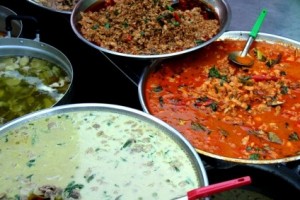
A Collection of Thai Curries and Rice
Curries are convenient to cook for parties since most can easily be prepared ahead of time and reheated just before serving. They also freeze well, which is a great convenience. Cooks should remember that some curries, such as curried salads, can be served cold and make good outdoor, summer food.
And what other dishes should be served with curries? Most curries are served with some form of rice, and plain white rice is an excellent accompaniment to most curries. The condiments are usually either served in bowls so that guests may sprinkle them over the curry, or are placed on the side of the individual dishes. Additionally, here is a general list of basic condiments often served with curries worldwide: fried eggplant, tamarind jam, candied coconut, candied ginger, pickled vegetables (such as onions), mango chutney, grated fresh coconut, grated roasted coconut, chopped peanuts or almonds, grated or slice hard-boiled eggs, chopped crisp bacon, chopped tomatoes, and salted fish.
Bafat (Hurry Curry)
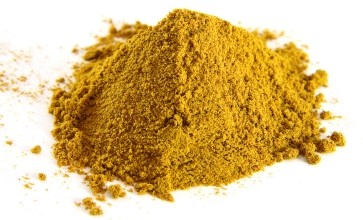
There are scores of curry powders on the market today. The purists may frown on curry powders, but they are indeed useful for making curries in a hurry. Even in India, curry powders have become an integral part of middle class family life. This curry powder, called bafat, is from the southwestern region of India. It can be used for a meat, fish, or any vegetable curry. It can even be used the same day for two completely different dishes, each with its own unique flavor! Traditionally, the spices are sun-dried for three days and then roasted.
1/3 cup coriander seeds
1/4 cup cumin seeds
2 tablespoons mustard seeds
2 tablespoons peppercorns
2 tablespoons whole cloves
1 tablespoon fenugreek seeds
2 tablespoons ground cardamom
2 tablespoons ground cinnamon
2 tablespoons powdered turmeric
1/4 cup freshly ground, hot chile powder
Dry the whole spices in the oven at 300 degrees F. for 15 minutes, taking care they do not burn. Remove them from the oven, cool, and grind them together with the ground and powdered spices in a spice mill in small batches. Mix all together in a bowl. Store in airtight jars.
Yield: About 1 3/4 cups
Heat Scale: Medium hot
Classic North Indian Curry Powder
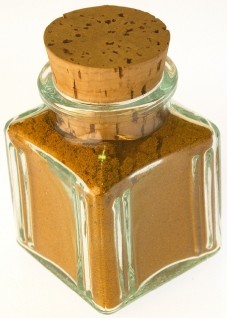
Here is a basic curry powder that utilizes the most common spices grown in India for centuries. Lacking a ready source of large Indian cayenne-type chiles, this particular powder uses a large amount of fairly mild New Mexican chiles, but cooks may substitute lesser amounts of hotter chiles. Traditionally in India, such spice mixtures are sun-dried, but these days the oven works quite well.
6 New Mexican red chiles, stems and seeds removed (or substitute 4 small, hot dried chiles, such as piquins)
1/4 cup cumin seeds
1/4 cup coriander seeds
2 tablespoons black peppercorns
1 tablespoon mustard seeds
1 teaspoon cardamom seeds
1 teaspoon whole cloves
1 teaspoon fenugreek seeds
1 tablespoon turmeric powder
1 tablespoon dried, powdered curry leaves
Preheat the oven to 250 degrees.
Place the chiles, cumin, coriander, peppercorns, mustard, cardamom, cloves, and fenugreek on a baking pan and place in the oven. Roast for 15 minutes, taking care that none of the spices burn. Grind these spices in a spice mill to a fine powder in small batches.
Mix the ground spices with the turmeric and the curry leaves in a bowl and seal in an airtight jar.
Yield: About 1 cup
Heat Scale: Medium
Ceylon Dark Curry Powder
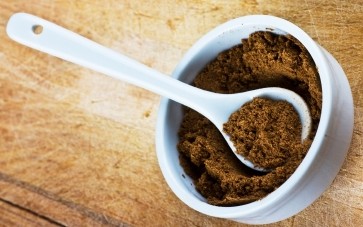
Some Sri Lankan curries are quite dark–almost black–because the various seeds that are used are toasted or roasted to a dark brown color. They are also quite hot, as is this basic southern powder.
10 small, hot dried red chiles, such as piquins, seeds and stems removed
1 tablespoon rice
1 tablespoon coconut, fresh or flakes
2 tablespoons coriander seeds
1 tablespoon cumin seeds
1 tablespoon fennel seeds
1 teaspoon cardamom seeds
1 teaspoon fenugreek seeds
1 2-inch piece cinnamon
1 teaspoon mustard seeds
6 whole cloves
5 curry leaves
Roast the chiles on a cookie sheet in the oven at 350 degrees until they turn very dark. Remove and allow them to cool.
In a dry skillet, roast the rice, coconut, coriander, cumin, fennel, cardamom, fenugreek, cinnamon, and mustard over medium heat, stirring often, until they turn dark brown, almost black, taking care that they do not burn.
Combine the chiles, roasted spices, cloves, and curry leaves in a spice mill and blend in small batches to a fine powder.
Yield: About 1 cup
Heat Scale: Hot
Cape Curry Powder

This blend of spices, with its mix of Malay and Indian influences, can be used in South African recipes calling for curry powder or in recipes from other parts of the continent. This recipes makes a medium-hot powder.
1/2 cup coriander seed
3 tablespoons cumin seed
1 tablespoon fennel seed
1 tablespoon mustard seed
1 tablespoon whole cloves
2 tablespoons black peppercorns
3 small, hot, red, dried chiles such as piquins or santakas, seeds and stems removed
4 tablespoons ground cardamom
3 tablespoons ground fenugreek
1 tablespoon ground ginger
1/4 cup ground turmeric
In a dry skillet, individually toast the coriander, cumin, fennel, mustard, cloves, and peppercorns over medium heat, taking care not to burn them.
Combine the toasted ingredients and the chiles in a spice mill and grind to a fine powder. Combine with the other ground ingredients and mix until a uniform color is achieved.
Yield: About 2 cups
Heat Scale: Medium-hot
Trinidadian Curry Paste
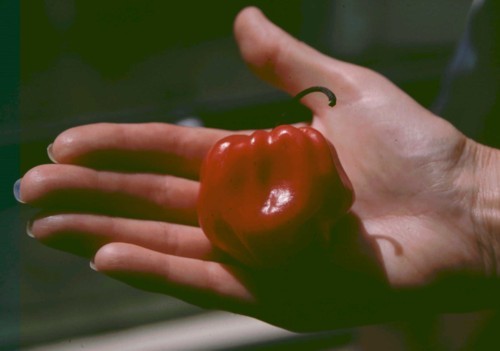
Many Caribbean curry powders and pastes lack chile peppers; however, this nineteenth century recipe from Trinidad calls for the large red Caribbean habanero chile, called “Congo pepper” there. Roast the spices in a dry skillet over medium heat, taking care that they don’t burn.
6 tablespoons roasted coriander seed
1 teaspoon roasted anise seed
1 teaspoon roasted cloves
1 teaspoon turmeric
1 teaspoon roasted cumin seed
1 teaspoon roasted fenugreek seed
1 teaspoon roasted black peppercorns
1 teaspoon roasted mustard seed
2 cloves garlic, chopped
1 large onion, chopped
1/2 habanero chile, seeds and stem removed, chopped (or substitute 3 red jalapenos)
Water as needed
Grind all the ingredients into a paste with a mortar and pestle, or use a food processor and puree.
Yield: 1 1/2 to 2 cups
Heat Scale: Hot





